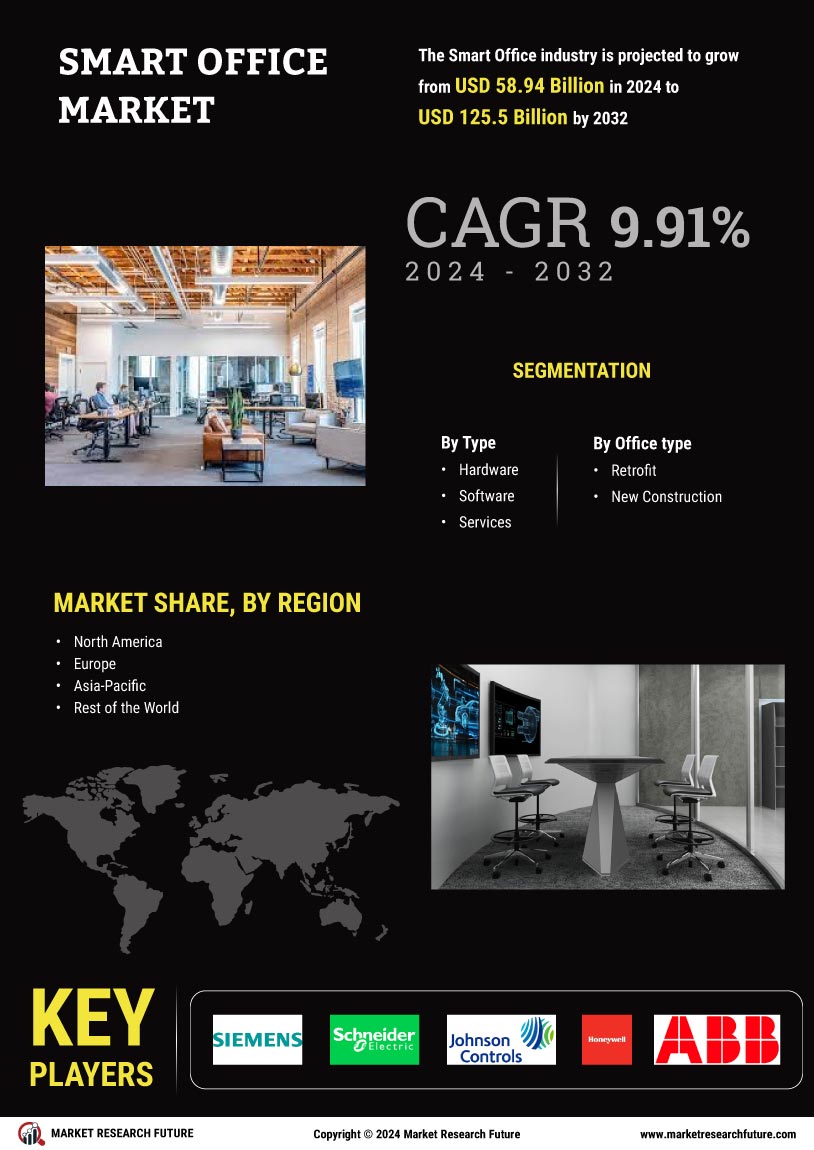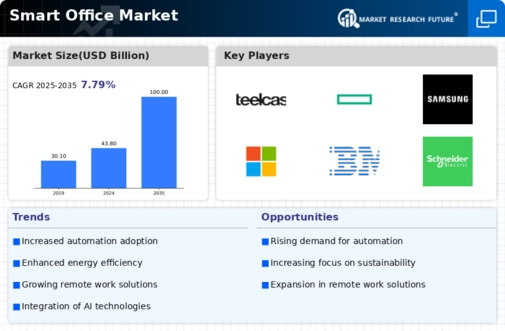Market Growth Projections
The Global Smart Office Market Industry is projected to experience substantial growth over the coming years. With a market valuation of 43.8 USD Billion in 2024, the industry is expected to reach approximately 100 USD Billion by 2035. This growth trajectory indicates a compound annual growth rate of 7.79% from 2025 to 2035. Factors contributing to this expansion include the increasing adoption of smart technologies, the demand for flexible workspaces, and the focus on sustainability. As organizations continue to embrace digital transformation and innovative solutions, the Global Smart Office Market Industry is likely to thrive, reflecting broader trends in workplace evolution.
Advancements in IoT Technology
The Global Smart Office Market Industry is significantly influenced by advancements in Internet of Things (IoT) technology. Smart devices and sensors are increasingly integrated into office environments, enabling real-time data collection and analysis. This technological evolution allows for enhanced energy management, improved security, and optimized resource allocation. For instance, smart lighting systems can adjust based on occupancy, leading to energy savings and reduced operational costs. As IoT technology continues to evolve, it is anticipated that the market will expand, potentially reaching a valuation of 100 USD Billion by 2035. The ongoing development of IoT solutions is likely to drive innovation within the Global Smart Office Market Industry.
Integration of Artificial Intelligence
The integration of artificial intelligence (AI) into office environments is emerging as a transformative driver within the Global Smart Office Market Industry. AI technologies facilitate automation, predictive analytics, and enhanced decision-making processes. For instance, AI-driven analytics can provide insights into workspace utilization, enabling organizations to optimize layouts and resource allocation. This capability not only improves operational efficiency but also enhances the overall employee experience. As AI continues to evolve, its applications within smart offices are likely to expand, contributing to the projected growth of the market. The Global Smart Office Market Industry is thus set to benefit from the ongoing advancements in AI technology.
Increasing Demand for Flexible Workspaces
The Global Smart Office Market Industry experiences a notable surge in demand for flexible workspaces, driven by the evolving nature of work. Companies are increasingly adopting hybrid models, necessitating adaptable office environments that can accommodate varying employee needs. This shift is reflected in the projected market value of 43.8 USD Billion in 2024, as organizations seek to optimize space utilization and enhance employee satisfaction. The integration of smart technologies facilitates seamless transitions between collaborative and individual workspaces, thereby improving productivity. As businesses recognize the benefits of flexibility, the Global Smart Office Market Industry is poised for substantial growth.
Enhanced Employee Experience and Productivity
The Global Smart Office Market Industry is witnessing a growing emphasis on enhancing employee experience and productivity through smart office solutions. Organizations are increasingly investing in technologies that promote collaboration, well-being, and engagement among employees. Features such as smart meeting rooms, personalized workspaces, and wellness-focused designs contribute to a more conducive work environment. Research indicates that companies adopting smart office technologies report higher employee satisfaction and retention rates. This trend is expected to drive market growth, as businesses recognize the correlation between employee experience and overall performance. The Global Smart Office Market Industry is thus positioned for continued expansion.
Focus on Sustainability and Energy Efficiency
Sustainability remains a pivotal driver within the Global Smart Office Market Industry, as organizations increasingly prioritize energy efficiency and environmentally friendly practices. The integration of smart technologies enables businesses to monitor and reduce their carbon footprint effectively. For example, smart HVAC systems can optimize energy consumption based on real-time data, contributing to lower operational costs and enhanced sustainability. This focus on green initiatives aligns with global trends towards corporate responsibility, potentially propelling the market to a compound annual growth rate of 7.79% from 2025 to 2035. As sustainability becomes a core business strategy, the Global Smart Office Market Industry is likely to witness accelerated growth.
























Leave a Comment